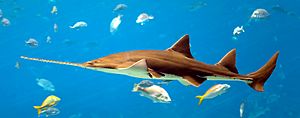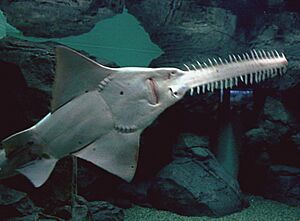Largetooth sawfish facts for kids
Quick facts for kids Largetooth sawfish |
|
|---|---|
 |
|
 |
|
| Conservation status | |
| Scientific classification | |
| Synonyms | |
|
The largetooth sawfish (Pristis pristis) is a special type of sawfish. It belongs to the family called Pristidae. You can find it in warm, tropical and subtropical coastal areas all over the world. It also lives in freshwater, like rivers. Sadly, its numbers have dropped a lot. Because of this, it is now a critically endangered species.
People have called this sawfish by many names. Some of these names include common sawfish, wide sawfish, freshwater sawfish, and river sawfish. It was also called Leichhardt's sawfish after a famous explorer.
Contents
About the Largetooth Sawfish
The scientific name Pristis comes from a Greek word. It means "saw," which makes sense for this animal! For a long time, scientists thought there were three different types of largetooth sawfish. These were P. pristis, P. microdon, and P. perotteti. But in 2013, new studies showed they are all the same species. Their bodies and genes are too similar to be separate species. So, P. microdon and P. perotteti are now seen as just other names for P. pristis.
Scientists have found three main groups of P. pristis based on their genes. These groups live in the Atlantic Ocean, the Indo-West Pacific Ocean, and the East Pacific Ocean.
What Does It Look Like?
The largetooth sawfish can grow very big. Some might reach up to 7.5 meters (25 feet) long. The longest one ever confirmed was 7 meters (23 feet) long. Most largetooth sawfish today are smaller, usually around 2 to 2.5 meters (6.5 to 8 feet) long. A very large one can weigh 500 to 600 kilograms (1,100 to 1,300 pounds). That's like a small car!
You can easily tell a largetooth sawfish apart from other sawfish. Its first dorsal fin (the fin on its back) is clearly in front of its pelvic fins (fins on its belly). It also has long pectoral fins (side fins) with pointy tips. Plus, it has a small lower lobe on its tail. Other sawfish species have their dorsal fin at or behind their pelvic fins. They also have shorter pectoral fins and no clear lower tail lobe.
The "saw" of the largetooth sawfish is wide. Its width is about 15–25% of its length. Each side of the saw has 14–24 teeth that are spaced out evenly. Females usually have shorter saws with fewer teeth than males. Young sawfish have longer saws in proportion to their body size.
The top of the largetooth sawfish is usually grey or yellowish-brown. Its fins often have a yellow tint. If they live in freshwater, they might look reddish. Their underside is greyish or white.
Where It Lives and Its Home
The largetooth sawfish lives in warm coastal areas around the world. But it also swims into freshwater. It has been found in rivers as far as 1,340 kilometers (830 miles) from the sea.
In the past, it lived in many places. This included the Atlantic Ocean, the Pacific Ocean, and the Indo-Pacific region. Its total home area was huge, covering almost 7.2 million square kilometers (2.8 million square miles). This was more than any other sawfish species. However, it has now disappeared from many of these places. For example, the last time one was seen in the Mediterranean Sea was in 1959.
Adult sawfish mostly live in estuaries (where rivers meet the sea) and ocean waters. They usually stay in shallow water, less than 10 meters (33 feet) deep. But they really like freshwater habitats more than some other sawfish species.
Some largetooth sawfish in Lake Nicaragua seem to live their whole lives in freshwater. But some do travel between the lake and the sea. These sawfish can live in both salt and freshwater. They are known to be very agile. They can even swim backward! They can also "climb" using their pectoral fins and jump high out of the water. One sawfish, 1.8 meters (6 feet) long, jumped 5 meters (16 feet) high! This might help them get past small waterfalls in rivers. They usually live in areas with sandy, muddy, or silty bottoms. They prefer water temperatures between 24 and 32 degrees Celsius (75–90°F). Water colder than 19 degrees Celsius (66°F) can be deadly for them.
Life Cycle and Behavior
Largetooth sawfish become ready to have babies when they are about 2.8 to 3 meters (9 to 10 feet) long. This happens when they are 7 to 10 years old. They are ovoviviparous, which means the mother carries the eggs inside her body. The babies hatch inside her and then are born live.
Breeding happens at certain times of the year. Female sawfish can have babies every 1 to 2 years. The pregnancy lasts about five months. Mothers might even return to the same area where they were born to give birth. Each mother has 1 to 13 babies, with about 7 on average. The babies are 72 to 90 centimeters (28 to 35 inches) long when they are born.
Young sawfish are usually born near river mouths in salty or brackish water. But they soon move into freshwater. They spend their first 3 to 5 years there, sometimes swimming up to 400 kilometers (250 miles) upstream. In the Amazon basin, young sawfish have been found even farther upriver. Sometimes, young sawfish get stuck in freshwater pools during floods. They can live there for many years. Scientists are not sure how long largetooth sawfish live, but some guess they could live up to 80 years.
The largetooth sawfish is a predator. It eats fish, molluscs (like snails), and crustaceans (like crabs). It uses its "saw" in two ways. It can stir up the bottom to find hidden prey. It can also slash at groups of fish to stun them. Sawfish are usually calm and do not harm humans. But if they are caught, they can cause serious injuries while trying to defend themselves with their saw.
Protecting the Largetooth Sawfish
The largetooth sawfish was once very common, as its old name "common sawfish" suggests. But its numbers have dropped greatly. Now, the IUCN (International Union for Conservation of Nature) lists it as critically endangered. The biggest danger to them is overfishing. They also lose their homes because of human activities.
Their fins are very valuable for shark fin soup. Their "saws" are also sold as unique items. Their meat is eaten as food. Because of their long "saws," they often get caught in fishing nets. In the past, people also hunted sawfish for the oil in their livers. In some parts of Nigeria, sawfish saws are used in traditional masquerades.
The largetooth sawfish has disappeared from many places where it once lived. Out of 75 countries where it was found, it is gone from 28. It might be gone from another 27 countries. This means it definitely still lives in only 20 countries. This is only 39% of its original home range.
Only Australia still has a fairly healthy population of this species. This might be the last strong group in the whole Indo-Pacific region. But even in Australia, their numbers have gone down. They are still found in very small numbers off Eastern Africa, India, and Papua New Guinea. In the East Pacific, they live off Central America, Colombia, and northern Peru. It is not clear if they still live anywhere in Southeast Asia.
The largetooth sawfish has disappeared from most of its Atlantic home. The biggest group left in this area is in the Amazon estuary. Another important group is in the San Juan River system in Central America. They used to be very common in Lake Nicaragua. But their numbers crashed in the 1970s when thousands were caught. Nicaragua has protected them since the early 1980s. But they are still rare in the lake today. A planned Nicaragua Canal now threatens them.
In 2007, all sawfish species were added to CITES Appendix I. This means that international trade of sawfish is now limited. The largetooth sawfish is protected in Australia and the United States. Many projects have started to help save them. It also has some protection in Bangladesh, Brazil, Guinea, India, Indonesia, Malaysia, Mexico, Nicaragua, Senegal, and South Africa. But illegal fishing still happens, and laws are not always enforced.
Young largetooth sawfish can sometimes be eaten by crocodiles and large sharks.
Sawfish in Aquariums
The largetooth sawfish is the most common sawfish found in public aquariums. However, they are often called by their old name, P. microdon, in aquariums. In 2014, there were 16 largetooth sawfish in North American aquariums. In 2013, there were 5 in European aquariums. In 2017, there were 13 in Australian aquariums. Other aquariums in Asia also keep them.
Images for kids
See also






